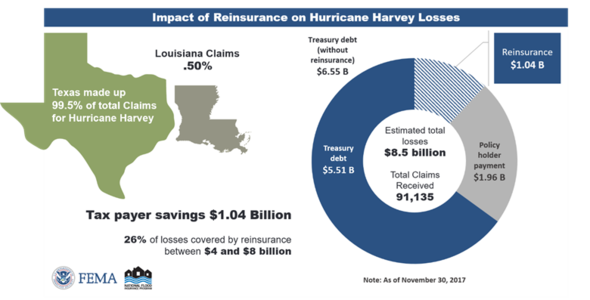|
Historically,
FEMA paid the National Flood Insurance Program’s (NFIP) claims of insured flood
survivors using insurance premiums, available surplus, borrowing capacity from
the U.S. Treasury, and in some cases direct Congressional appropriations. In
2017, FEMA added a new risk management tool—reinsurance---to
protect the NFIP from large financial losses. As a result, the NFIP has an
additional tool within its financial framework to manage losses that result
from major events such as Hurricane Harvey.
In
January 2017, FEMA made a historic cornerstone placement of reinsurance to
establish a multi-year reinsurance strategy. Reinsurance is an important risk
management tool used by insurance companies and public entities to protect from
large financial losses. Insurance providers pay premiums to reinsurers. In
exchange, reinsurers provide coverage for losses incurred by insurance
providers up to a specified amount.
Under the 2017 Reinsurance
Agreement, FEMA transferred $1.042 billion in
flood risk to the private reinsurance markets. This extends the NFIP’s flood
claims-paying ability by protecting against a portion of its potential losses. During the calendar year, when NFIP losses exceed $4 billion, the NFIP will
receive $0.26 for every dollar of losses between $4 and $8 billion, up to a
maximum of $1.042 billion.
In
early November, FEMA surpassed $4 billion in paid claims to insured flood
survivors of Hurricane Harvey, triggering the NFIP 2017 reinsurance placement. FEMA sent an initial proof
of loss to reinsurers on December 5, 2017, requesting
the entire $1.042 billion in reinsurance.
For more information, read,
“Behind the Scenes,
Private Sector Helps Harvey Survivors through Reinsurance,” at FEMA.gov/blog.

The Ready Campaign’s Holiday and
Travel Safety Social Media Toolkit provides preparedness information
and graphics to promote winter safety.
The main tips for holiday and travel
safety include:
- Stay
off the road during and after a winter storm.
- Keep
candles away from flammable materials or consider using flameless candles
instead.
- Keep
an eye on food when cooking.
- Turn
off holiday lights at night.
- Keep
your tree watered. Do not let your holiday tree dry out.
For more tips, hashtags, promotional content,
Twitter, and Facebook messages, visit www.ready.gov/holiday-toolkit.

|